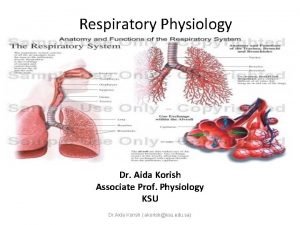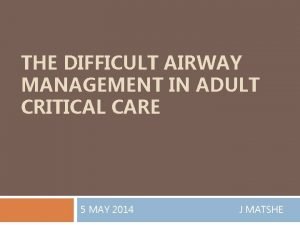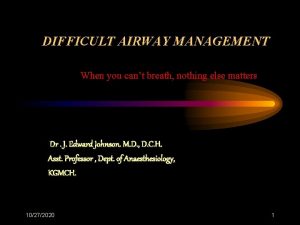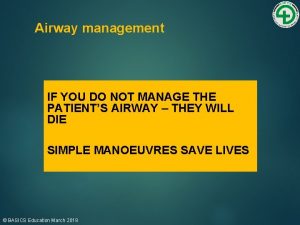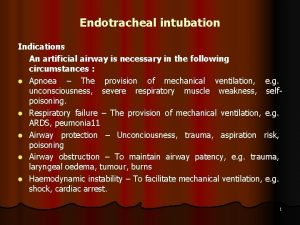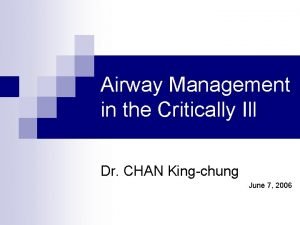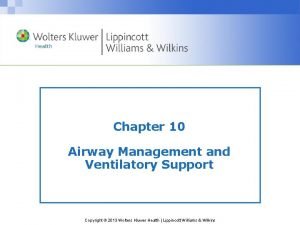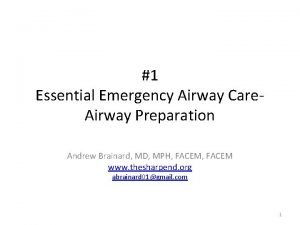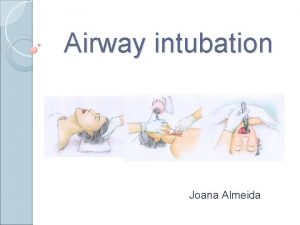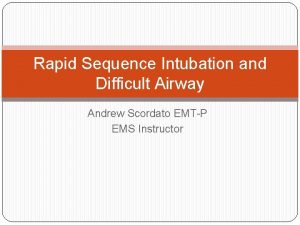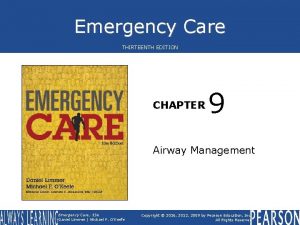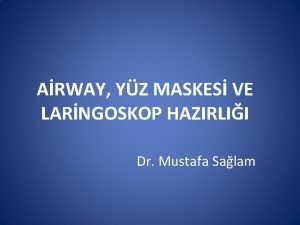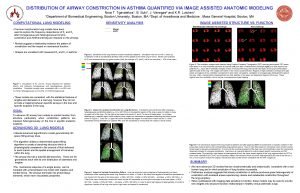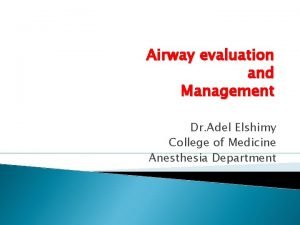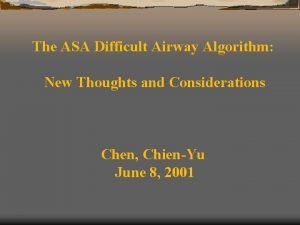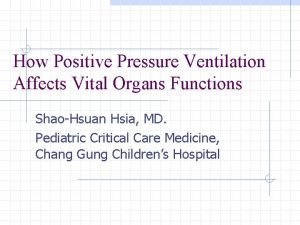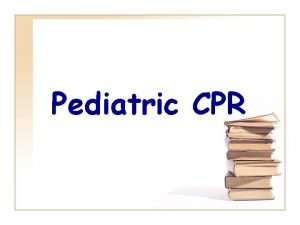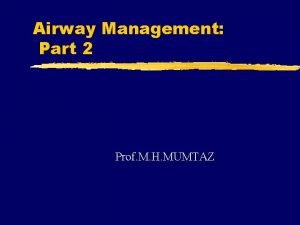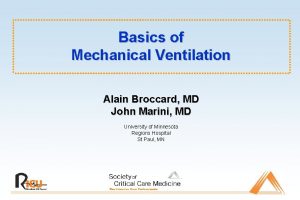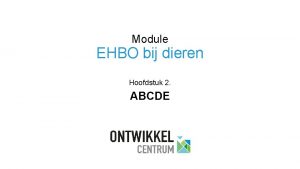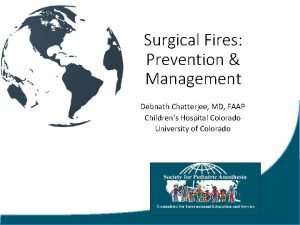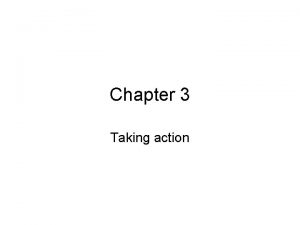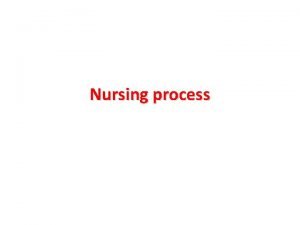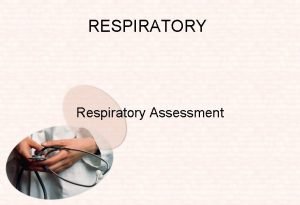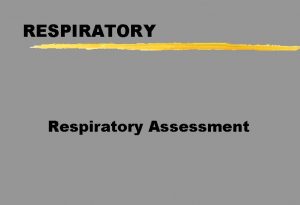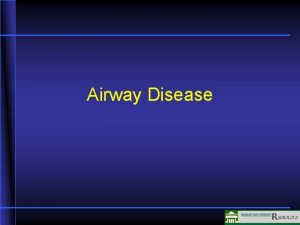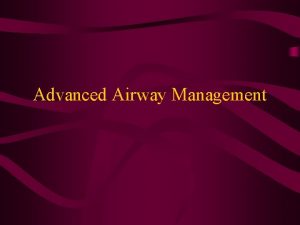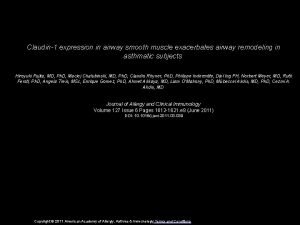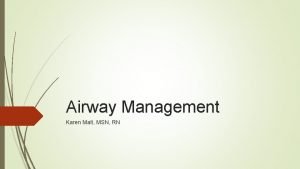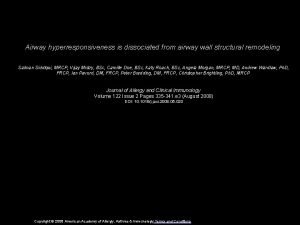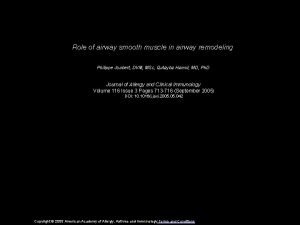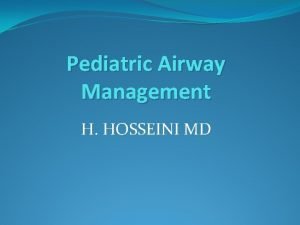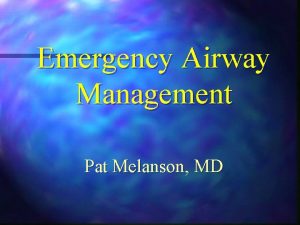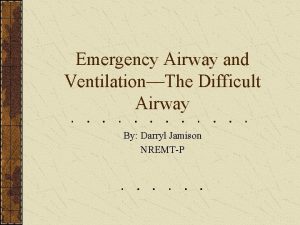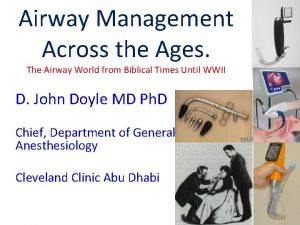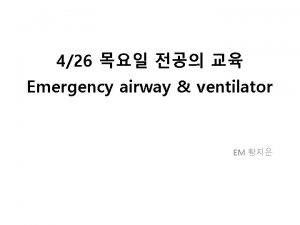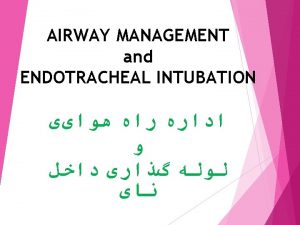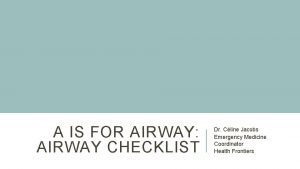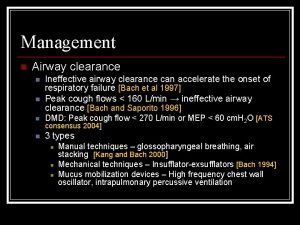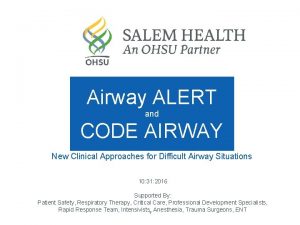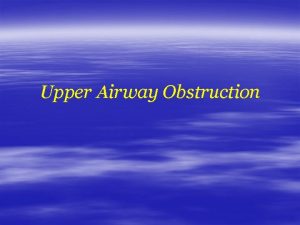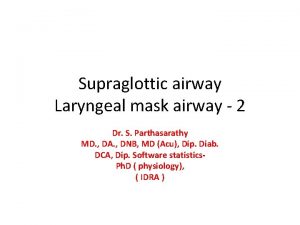RESPIRATORY Respiratory Assessment Respiratory Assessment z Airway y

































- Slides: 33

RESPIRATORY Respiratory Assessment

Respiratory Assessment z. Airway y. Listen - To Pt. Breathe or Talk x. Noisy Breathing is Obstructed Breathing x. Not All Obstructed Breathing is Noisy x. Snoring - Tongue Blocking Airway x. Stridor - “Tight” Upper Airway from Partial Obstruction

Respiratory Assessment y. Anticipate Airway Problems in Patients With: x. Decreased LOC x. Head Trauma x. Maxillofacial Trauma x. Neck Trauma x. Chest Trauma y. OPEN - CLEAR - MAINTAIN

Respiratory Assessment z. Breathing y. Is the Pt. Moving Air? y. Is the Pt. Moving Air Adequately? y. Is the Pt’s Blood Being Oxygenated?

Respiratory Assessment y. LOOK - LISTEN - FEEL x. Look for Symmetry of Chest Expansion x. Look for Signs of Increased Respiratory Effort x. Look for Changes in Skin Color x. Listen for Air Movement at Mouth & Nose x. Listen for Air Movement in Peripheral Lung Fields x. Feel for Air Movement at Mouth & Nose x. Feel for Symmetry of Chest Expansion

Respiratory Assessment y. Tachypnea/Bradypnea? y. Orthopneic? y. Signs of Respiratory Distress x. Nasal Flaring x. Tracheal Tugging x. Retractions x. Accessory Muscle Use x. Use of Abdominal Muscles on Exhalation

Respiratory Assessment y. Cyanosis? (Late, unreliable sign of Hypoxia) y. Oxygenate Immediately! Especially If: x. Decreased LOC x. Possible Shock x. Possible Severe Hemorrhage x. Chest Pain x. Chest Trauma x. Respiratory distress or dyspnea x HX of any Kind of Hypoxia

Respiratory Assessment y. Consider Assisting Ventilations x<10 x>24 x. Insufficient Inspiratory O 2 Volume Inadequate) (Tidal y. If the Pt. Has compromised breathing, bare the chest and assess for: x. Open Pneumothorax x. Flail Chest x. Tension Pneumothorax

Respiratory Assessment y. Platitudes x. IF YOU CAN’T TELL WHETHER A PT. IS MOVING AIR ADEQUATELY, HE ISN’T! x. THE NEED TO INTUBATE IS NOT THE SAME AS THE NEED TO VENTILATE! x. IF YOU THINK ABOUT GIVING O 2, GIVE IT!

Respiratory Assessment z. Circulation y. Is the heart beating? y. Is there major external hemorrhage? y. Is the Pt. Perfusing? y. Effects of hypoxia: x. Early in adults - Tachycardia x. Late in adults - Bradycardia x. Children - Bradycardia

Respiratory Assessment y. Don’t let respiratory failure distract you from assessing for circulatory failure. y. Vascular Access

Respiratory Assessment z. Disability y. Restlessness, anxiety, combativeness = HYPOXIA Until Proven Otherwise y. Drowsiness, lethargy = HYPERCARBIA When the Pt. Stops fighting, he is not necessarily getting better

Respiratory Assessment z. Chief Complaint y. Dyspnea x. Subjective sensation that breathing is excessive, difficult, or uncomfortable

Respiratory Assessment y. HX of Present Illness x. How long has dyspnea been present? x. Gradual or sudden onset? x. What aggravates or alleviates? x. Coughing? x. Productive cough? x. What does sputum look/smell like? x. Pain?

Respiratory Assessment z. Secondary Assessment y. Respiratory Pattern x. Kussmaul x. Cheyne-Stokes x. Central Neurogenic Hyperventilation

Respiratory Assessment z. Secondary Assessment y. Neck x. Trachea Midline? x. Jugular Vein Distention? x. Sub-cutaneous Emphysema? x. Accessory Muscle Use/Hypertrophy?

Respiratory Assessment z. Secondary Assessment y. Chest x. Barrel Chest? x. Deformity/Discoloration/Symmetry? x. Flail Segment/Paradoxical Movement? x. Breath Sounds? x. Adventitious Sounds?

Respiratory Assessment z. Secondary Assessment y. Chest x. Third Heart Sounds? (S 3) x. Tenderness/Instability? x. Sub-cutaneous Emphysema? x. Fremitus? x. Symmetrical Expansion? x. Dullness/Hyperresonance to Percussion?

Respiratory Assessment z. Secondary Assessment y. Extremities x. Pre-tibial/Pedal Edema x. Nailbed Color x“Clubbing” of digits

Adventitious Sounds z. Snoring respiration y. Upper Airway y. Partial obstruction of the upper airway by the tongue z. Stridor y. High pitched crowing sound y. Usually heard on inspiration y. Indication of a tight upper airway

Adventitious Sounds z. Wheezing y. Whistling sound y. Usually heard on expiration y. Indication of narrowing of lower airways caused by: x. Bronchospasm x. Edema x. Foreign material

Adventitious Sounds z. Rhonchi y. Rattling sound y. Caused by mucus in larger airways z. Rales y. Fine crackling sound y. Indication of fluid in the alveoli

Adventitious Sounds z. Cough y. Forced exhalation against partially closed glottis y. Reflex response to mucosa irritation y. Determine circumstances x. At work x. Postural changes x. Lying down y. Productive vs non-productive

Adventitious Sounds z. Sneeze y. Forced exhalation via nasal route y. Clears nasal passages y. Reflex response to mucosa irritation z. Sighing y. Slow, deep inspiration - Prolonged, audible exhalation y. Reexpands areas of atelectasis

Adventitious Sounds z. Hiccough y. Hiccups, singultus y. Spasm of diaphragm followed by glottic closure y. No useful purpose y. Benign, transient

Adventitious Sounds z. Hiccough z. Usually corrected by: y. Breath-holding y. Rebreathing from paper bag y. Valsalva maneuver

Adventitious Sounds z. Hiccough z. Serious causes include: y. Brain stem lesions y. Increased intracranial pressure y. Renal failure y. Pancreatitis y. Hepatitis y. Liver cancer y. Pneumonia

Chief Complaint z. Dyspnea - Sensation that breathing is: y. Excessive y. Difficult y. Uncomfortable

History of Present Illness z. How long? z. Onset gradual or sudden? z. What makes it better of worse? z. Cough? y. Productive? y. Sputum color? z. Pain? y. What kind?

Past History z. Hypertension, AMI, diabetes y? CHF with pulmonary edema z. Chronic cough, smoking, recurrent flu y? COPD z. Allergies, acute/seasonal SOB episodes y? Asthma

Past History z. Lower extremity trauma, recent surgery, immobilization y? Pulmonary embolism

Medications z. Breathing Pills, Inhalers y. Bronkodyl y. Bronkolixer y. Brokotabs y. Elixophyllin y. Theo-Dur y. Theofort z. Asthma

Medications z. CHF y. Lasix y. Diuril y. Hydrodiuril y. Digitalis
 Airway grade view
Airway grade view Respiratory airway secretary
Respiratory airway secretary Airway assessment in anaesthesia
Airway assessment in anaesthesia Head tilt chin lift jaw thrust
Head tilt chin lift jaw thrust Larangoscopy
Larangoscopy Conducting zone of the respiratory system function
Conducting zone of the respiratory system function Opa and npa
Opa and npa Mechanism of breathing
Mechanism of breathing Indications for artificial airway
Indications for artificial airway Asp medical clinic
Asp medical clinic Outside the classroom
Outside the classroom Thyromental distance
Thyromental distance What is mean airway pressure
What is mean airway pressure Basic airway management equipment
Basic airway management equipment Airway view
Airway view Tracheostomy stoma
Tracheostomy stoma How will you open the casualty's airway
How will you open the casualty's airway Moans airway
Moans airway Sniffing position for intubation
Sniffing position for intubation Soap me airway
Soap me airway Chapter 9 airway management
Chapter 9 airway management Airway numaraları
Airway numaraları Noratbj
Noratbj Nasopharyngeal airway
Nasopharyngeal airway Difficult airway algorithm asa
Difficult airway algorithm asa Mean airway pressure
Mean airway pressure A airway b breathing c circulation
A airway b breathing c circulation Ztechnique
Ztechnique Upper respiratory tract
Upper respiratory tract Mean airway pressure formula
Mean airway pressure formula Abcde methode ehbo
Abcde methode ehbo Silverstein fire risk assessment tool
Silverstein fire risk assessment tool The emergency action steps are
The emergency action steps are Short term goal ncp
Short term goal ncp

